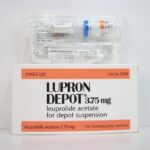How Fast Does Cabergoline Start Working After You Take It?

When our body begins to metabolize a medication, different organs process the ingredients before they are finally released into the bloodstream. While the process may sound straightforward, different drugs dissolve at different rates, different formulas, and dosages break down differently – and, everybody’s body metabolizes medication uniquely. These are just a few of the many complexities behind the nature of drug absorption and metabolism.
The vast majority of medications are taken orally and are broken down within the gastrointestinal tract. Once the medication arrives, it is broken down by stomach acids before it passes through the liver and then enters the bloodstream. Certain medications may stay in the bloodstream longer – it all depends on the dosage and drug family consumed.
There are several factors at play when determining the overall time required for medication to fully digest. The following factors all impact an individual’s sensitivity to and absorption of medication:
• Age
• Weight
• Gender
• Time of day taken
• Level of physical activity
• Level of stress
• Content of stomach and PH level
• Presence of other medications
Gastric acids may prevent or slow the breakdown of certain medications. Additionally, when a medication is metabolized in the liver, its potency will decrease along with its effectiveness before the medicine reaches the bloodstream.
What is cabergoline?
Cabergoline oral tablet is a prescription drug used to treat hyperprolactinemia (high levels of prolactin in your body). This happens when your pituitary gland makes extra prolactin. High prolactin levels may be caused by a hormone problem or by a tumor in your pituitary gland.
High prolactin levels can cause changes in a woman’s ovulation, menstrual cycle, and breast milk production. In men, high prolactin levels can affect reproduction and cause sexual issues. These issues include a decreased sex drive and not being able to get or keep an erection.
How Cabergoline works
Cabergoline belongs to a class of drugs called dopamine agonists. A class of drugs is a group of medications that work in a similar way. These drugs are often used to treat similar conditions.
Dopamine is a chemical your body makes. It prevents your body from releasing prolactin. Cabergoline works by binding to dopamine receptors. This also keeps your body from releasing prolactin, which helps decrease your prolactin levels.
How to take Cabergoline
Take this medicine exactly as directed by your doctor. Do not take more of it, do not take it more often, and do not take it for a longer time than your doctor ordered. To do so may increase the chance of side effects.
You may take this medicine with or without food.
The dose of this medicine will be different for different patients. Follow your doctor’s orders or the directions on the label. The following information includes only the average doses of this medicine. If your dose is different, do not change it unless your doctor tells you to do so.
The amount of medicine that you take depends on the strength of the medicine. Also, the number of doses you take each day, the time allowed between doses, and the length of time you take the medicine depend on the medical problem for which you are using the medicine.
- For oral dosage form (tablets):
- For disorders of high prolactin levels or pituitary tumors:
- Adults—At first, 0.25 milligram (mg) 2 times a week. Your doctor may increase your dose every 4 weeks as needed, according to body prolactin levels, up to 1 mg two times a week.
- Children—Use and dose must be determined by the doctor.
- For disorders of high prolactin levels or pituitary tumors:
If you miss a dose of this medicine, take it as soon as possible. However, if it is almost time for your next dose, skip the missed dose and go back to your regular dosing schedule. Do not double doses.
However, if it is almost time for your next dose, check with your doctor to see if you can double your dose.
What is the best time to take cabergoline?
The best time to take cabergoline oral tablet is at night after your last meal before going to bed. This is because cabergoline can make you feel a bit dizzy, or cause nausea or headaches. Taking the medication as the last thing at night before going to bed reduces the risk of these unwanted side effects and discomfort associated with the medication.
Cabergoline oral tablet is used for short-term treatment. It comes with serious risks if you don’t take it as prescribed. If you stop taking the drug suddenly or don’t take it at all, the levels of prolactin in your blood will stay high. In women, high prolactin levels can change ovulation, menstrual cycles, and breast milk production. In men, high prolactin levels can affect reproduction and cause sexual issues. These include a decreased sex drive and not being able to get or keep an erection.
How long does it take for cabergoline to work?
Studies have shown that the effects of cabergoline begin immediately, it triggers a fall in serum prolactin within 3 hours. Cabergoline is a long-acting agonist capable of inhibiting pituitary prolactin secretion for more than 7 days after a single dose. Oral dosing is started at 0.25 mg twice a week or 0.5 mg weekly. This dosage is often sufficient to normalize prolactin levels. The maximal decrease in serum prolactin ranges between –49.2% and -55.2% and occurred after 2-5 days after starting the drug.
How long does Cabergoline stay in your system?
Cabergoline’s elimination half-life was calculated from urine data of 12 healthy participants and varied from 63 to 69 hours. Cabergoline’s sustained prolactin-lowering impact may be due to its slower elimination and lengthy half-life.
Does Cabergoline increase testosterone?
Cabergoline decreases the prolactin levels in the blood, which leads to an increase in testosterone concentration. Cabergoline treatment normalizes prolactin and testosterone levels in hyperprolactinemia males, improves gonadal and sexual function, fertility, and can be used as therapy in men with large macroprolactinomas.
Can Cabergoline delay periods?
No, Cabergoline does not delay periods. Cabergoline safely treats menstrual irregularity in PCOS individuals with moderate hyperprolactinemia. Cabergoline helps to improve irregular menstrual periods and may shorten the duration. Always get a medical opinion from your physician before using this medication for PCOS.
Can I get pregnant while taking Cabergoline?
Yes, you can get pregnant while consuming Cabergoline supplements. Recent findings state about 70 to 85 percent of women get pregnant after taking Cabergoline. In all of the women, treatment with Cabergoline reversed ovulation and stabilized blood prolactin levels.
Does Cabergoline cause spotting?
No, Cabergoline does not cause spotting. Spotting is vaginal bleeding, whereas Cabergoline does not lead to irregular cycles. Treatment with Cabergoline can regulate irregular menstrual cycles in women. Clinical studies show that Cabergoline can improve ovulation and significantly reduces the chance of anovulation.
Can Cabergoline cause twins?
Yes, some of the clinical studies show that Cabergoline causes twins without any abnormalities. Nearly eighty-five percent of women who take this drug ovulate, and 70 to 80 percent of those who ovulate become pregnant.
Does Cabergoline increase fertility?
Yes, Cabergoline obtained a high pregnancy rate with uneventful results. Women with infertility issues also get pregnant after taking this medication. Cabergoline is taken twice a week in the form of one to two pills. If no other reasons for infertility are present, around 80 percent of the women treated will ovulate and become pregnant.
Does Cabergoline affect mood?
Yes, Cabergoline affects mood. Cabergoline can induce mental/ emotional side effects such as sadness, anxiety, sleeplessness, decreased attention, nervousness, hallucinations, nightmares, psychosis, and mania. Take your prescription as directed by your doctor, and if you have any side effects, please visit a nearby local hospital.
What are the side effects of cabergoline?
Cabergoline may cause side effects. Tell your doctor if any of these symptoms are severe or do not go away:
• nausea
• vomiting
• heartburn
• constipation
• tiredness
• dizziness
• breast pain
• painful menstrual periods
• burning, numbness, or tingling in the arms, hands, legs, or feet
Some side effects can be serious. If you experience any of these symptoms, call your doctor immediately or get emergency medical help:
• shortness of breath
• difficulty breathing when lying down
• cough
• chest pain
• swelling of the hands, feet, ankles, or lower legs
• decrease in urination
• pain in the back, side, or groin
• lumps or pain in the stomach area
• abnormal vision
Cabergoline may cause other side effects. Call your doctor if you have any unusual problems while taking this medication.
If you experience a serious side effect, you or your doctor may send a report to the Food and Drug Administration’s (FDA) MedWatch Adverse Event Reporting program online (http://www.fda.gov/Safety/MedWatch) or by phone (1-800-332-1088).





